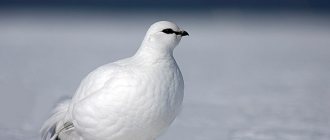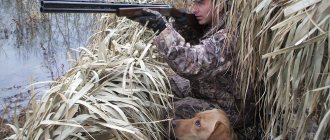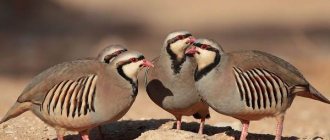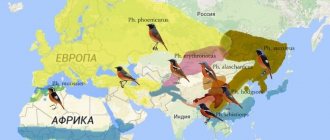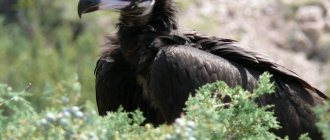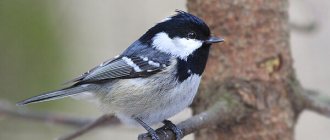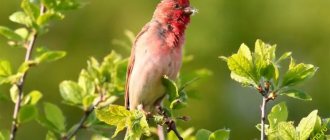Partridge is a valuable trophy for all hunters and a desirable dish for gourmets. Its meat remains soft during boiling, stewing, baking and even frying. The bird got its name due to some similarities with chicken. Below we will get acquainted with several types of partridges, and also find out their difference from quails and black grouse.
Gray partridge looks like a chicken
The partridge is a bird that does not like to fly
The partridge is a well-known, widespread bird. Its name in all Slavic languages means a bird similar to a chicken. It inhabits Eurasia and was introduced to America. Hunters took care of transporting the bird to the American continent. It is they who show increased interest in this little-remarkable bird.
World culture has not ignored the partridge. An ancient Greek myth tells about the unseemly act of the ambitious architect Daedalus. He threw off a cliff a student who surpassed him in skill. But the young man did not die. Athena turned him into a partridge. Remembering this fall, partridges do not like to fly high and stay on the ground most of the time.
Description and features
The partridge is most easily described as a small chicken with motley colors. Its weight is 500-700 grams, and its length reaches 40 cm. The round body is supported by strong legs. Males and females have no spurs on their legs.
The general color scheme depends on the habitat and can be brown, brown, red, almost white. The feather cover is not evenly colored; there are streaks of different sizes and colors. The coloring of the bird suggests that the main defense strategy is camouflage.
Birds molt annually. This happens in the middle of summer. Females molt after finishing hatching their offspring. The largest flight feathers fall out first. By the end of summer, the main feathers are completely renewed. In autumn it’s the turn of contour feathers. By the beginning of winter, molting ends.
The white partridge has a pronounced seasonal difference in color . Winter cover is white. Except for some tail feathers. They are black. The rest of the time they are brown, red, with a white lower body.
Sexual dimorphism is manifested in the size of the bird: males are larger. Bettas have slightly brighter colored feathers. Externally, the birds of both sexes are so similar that only a specialist will be able to recognize whether the partridge in the photo is male or female.
Number of individuals
Before you start raising this bird, you should decide on the scale - will the matter be limited to personal needs or will the carcasses and eggs be sold. In any case, starting with more than 10 individuals is risky.
If you conduct business, you will have to register so as not to have problems with the tax authorities in the future.
You can get new additions to your enclosure by catching partridges in their habitat or ordering from farmers. Another affordable way is to buy eggs (you will need an incubator to hatch them). You can find out how much a partridge costs by studying the advertisements - prices depend on the species. The average cost of 1 individual chukar is 1 thousand rubles.
Kinds
Partridges are a whole genus of birds that goes by the name Perdix. The genus belongs to the pheasant family. Turkeys, pheasants, and peacocks are related to partridges. guinea fowl, black grouse, that is, all chicken-like animals.
Most are classified in the pheasant family, partridge subfamily:
- The gray partridge is a species that includes 8 subspecies. Its taxonomic name is Perdix perdix. This is the most common partridge.
- The Tibetan partridge breeds in Central Asia. The species contains three subspecies. The scientific name of the species is Perdix hodgsoniae.
- Bearded partridge - looks like a gray partridge. Breeds in Siberia and Manchuria. The species is divided into two subspecies. The system name is Perdix dauricae.
- Chukar or stone partridge is predominantly gray in color with an ashy tint. The beak and paws are red.
- The desert partridge's plumage color is very similar to the chukar partridge, but has a pink tint. The plumage on the wings consists of black and white stripes.
- Bush partridge. A medium-sized bird with a brown color, with mottled plumage and small black, brown and cream spots on the sides and a brown back.
- Bamboo partridge. Small in size with pronounced sexual dimorphism. Variegated plumage in black, brown and cream colors.
- Shportsevaya. It has gray-brown plumage; the male has a bright color with small ripples that extend to the crest. There are spurs on the paws.
- The snowy partridge is feathered with black and white stripes up to the head. The beak is red.
- Madagascar. Endemic to the island, the bird itself is very large, females are mottled gray, males are larger with brighter plumage.
- Crowned or tufted partridge. The bird has an unusual color. The body is almost black with blue in males and green in females. There is a crest on the head.
For the most common gray partridge, natural nesting areas are all of Europe and Western Asia. This species has been introduced to other continents. Became widespread in Canada, the United States, South Africa, Northern Australia and Tasmania.
Subfamily of grouse, genus of white partridges:
- White partridge. In summer it is reddish-gray, but most of it is white, the eyebrows are scarlet. In spring it is red-brown, and the rest of the plumage is snow-white. In total, the bird changes plumage 3-4 times a year
- Tundra. The plumage of the male is distinguished by individual black-brown feathers on the head and shoulders. In summer it is brighter gray with stripes and spots. In winter they are white, the male has a black stripe across the eyes, the female does not have it.
- White-tailed, plumage like a white partridge, the difference is the white tail.
Vocalization
Gray partridges in flocks look for places with tasty food, and when they find it, they make sounds “gook.gook.gk”, reminiscent of the clucking of chickens. Wary partridges make muffled “coo-kut-kut” noises. As they fly, frightened wild hens cry out anxiously, “chip-chip, chip.chip.kippipipip.” For males, as well as for females, the most typical call is one that sounds like a creaking “chirr” or “chirrik”. Most often, males make this call when they are on some elevation - this is both a signal of location and a threat to the opponent. During the mating season, males, staying in their area, often emit a peculiar cry “kierr-kek”; females at this time make frequent “pit-pit-pit-pit.” Both the female and the male call the chicks with a special clucking sound, reminiscent of a chicken's, but with a sharp increase in tone at the end of each sound. A female disturbed on the nest may hiss threateningly.
Lifestyle and habitat
For the main part of the year, birds stay in groups, small flocks, which often form around an unbroken brood. Collectivism is characteristic of group members. Birds survive the cold nights by huddling together. During flock feeding and daytime rest, one or two birds remain on duty and monitor the situation.
Partridges are sedentary birds. Their flocks sometimes change nesting territories. The reason for migration may be overpopulation of the area. This happens when numerous offspring are successfully raised.
The harsh winter forces us to hit the road. Partridges living in mountainous areas like to settle in the lowlands for the winter. Development of territories and human economic activities also force birds to wander.
Partridges do not like to fly. They spend most of their time on the ground. They take to the air only in case of danger. Not the best aerodynamic qualities are confirmed by the noise that accompanies their takeoff. When climbing and in flight, fast and sonorous strokes alternate with gliding.
The ability to fly, run quickly on the ground and hide well does not provide partridges with safety. All predators, from domestic cats to foxes and wolves, scour the fields in search of nests and flocks of partridges. Feathered aggressors - hawks, buzzards, harriers - are no less dangerous than ground-based ones.
In addition to predators, winter tests the viability of partridges. In places with mild winters and little snow, partridges live in flocks. They are located near winter fields, along the banks of reservoirs, in thickets of bushes. The flock manages to feed itself from a territory of 1 square meter. km.
During snowless winters, partridges gather in a dense group to spend the night. They hug each other closely. They form a circle of birds with their heads pointing outward. This configuration allows all individuals to take off at once in case of alarm.
In the event of a snowy winter, each bird is housed separately. Spends the night in a snow chamber. There have been cases when partridges disappeared into the snow after flying. They made passages and arranged places to spend the night in the snow.
Cold winters, dry summers, and terrestrial and avian predators are serious existential threats. Nature has found a way: the partridge bird wins its place in the sun through fertility and the rapid maturation of its offspring.
Where to begin?
By and large, anyone who has at least a small utility room can start breeding and keeping partridges at home. If you wish, you can even set up this business in a garage, although a country house with two dozen acres of adjacent land would, of course, be better for these purposes. Moreover, if the business is illegal at first, as is often the case with us, it is much easier to hide from the tax authorities in the village than in the middle of a metropolis.
The first thing any commercial project begins with is drawing up a clear business plan. Before purchasing building materials for a chicken coop and looking for poultry suppliers, you should carefully calculate all costs, find out how to sell finished products and current prices for them. Only after making sure that the project will be profitable under current circumstances can you begin to create a farm.
Since not many enterprises are engaged in breeding partridges in Russia (which, in fact, is good, because the competition will be low), you may have to go to another region several hundred kilometers to get the first batch of young animals. It is better to purchase several pairs (unlike most poultry, partridges are monogamous), having received offspring from which in the future it will be possible to form the required number of livestock.
Usually, at the start, 4-5 pairs of adult partridges are purchased, but you can purchase chicks or even eggs. Purchasing adult birds carries less risk, although it will cost much more. On the other hand, an entrepreneur with extensive experience in poultry breeding can safely start with incubation.
Nutrition
Partridges are happy with a vegetarian diet. Grains of cultivated cereals, spring and winter, are an essential part of bird nutrition. Greens, young shoots and roots, and weed seeds supplement the diet. The seeds and fruits of trees, even birch catkins, are actively consumed by birds.
Birds' diet includes insects. They are especially abundant when inspecting plowed fields. In winter, partridge often moves closer to human habitation. On the one hand, the number of threats to her life increases. On the other hand, there are chances to feed themselves near elevators and granaries.
Premises requirements
Home breeding of gray partridge requires the obligatory arrangement of a suitable premises. Its size should correspond to the number of birds kept. So, there should not be more than three of them per square meter. For overnight stays, as a rule, a closed room (barn, log house) is equipped. The floor is covered with straw and all cracks are carefully sealed, since the gray partridge is very sensitive to drafts. It is worth stretching the net under the ceiling, because when flying, the birds can hit the wooden flooring and get injured.
Like all other birds, partridges love fresh air. Therefore, the presence of high enclosures covered with mesh is mandatory. Bushes are placed inside them, sheaves and fir trees are placed, which will serve as a shelter for the birds. In order to be able to hide from bad weather, they make a small canopy, closed on one side. The enclosure should have drinking bowls, feeders, and containers with sand.
Reproduction and lifespan
In the Northern Hemisphere, in areas with a temperate climate, the mating season begins in February. Males are becoming more active. They select sites for future nests. They begin to talk. Mating behavior consists of performing displaying poses, movements and sounds.
The pairing is done slowly. Partners who created an alliance last season and survived until the new spring most often form a couple again. The initiator in choosing a partner is the female.
The choice is not always final. Before the pair has time to form, it breaks up and the female chooses a new partner. In a flock, some males may be left without a mate. They join other groups of birds. Where the selection process is not completed.
After the initial formation of a pair, the initiative passes to the male. He takes care of the inviolability of the territory where the nest is supposed to be built. Arranges battles with competitors. Caring for the female. At this time she is building a very simple nest. In fact, this is a hole in the ground in a shaded place, which has the shape of a bowl with a diameter of 17-20 cm, a depth of 5-8 cm and is covered with dry grass.
Pairing and courtship takes about a month. Birds begin to mate starting in April. Copulation ends with clutch. The partridge lays from 10 to 18 eggs. Ornithologists have recorded cases of clutches consisting of 25 or more pieces. Partridge eggs correspond to the size of the bird: the long side is 4 cm, the short side is 3 cm.
The female does the incubation. Incubation ends after 23-26 days. The chicks emerge almost simultaneously, within a few hours. The offspring are ready to move immediately after emergence. The mother leads the chicks away from the birthplace. A male joins the brood. After an hour, the family finds itself 100-200 meters from the nest and never returns to it.
After a week, the chicks begin to take flight, and after two weeks they begin to fly long distances. Despite the rapid maturation, the brood, as an association, persists until autumn, and sometimes until winter. Can serve as a base group for creating a new flock.
Hatching chicks
The partridge begins laying eggs in May. The egg is usually up to 33 mm long, pear-shaped and greenish-brown in color. A nest is prepared in advance from an old basket or tall box measuring 30x30 cm so that the chicks cannot subsequently jump out of it. The bottom is covered with straw or hay. Such a nest should be installed in a dry, ventilated room, where all cracks and openings through which rats, cats or ferrets can enter must be sealed.
The period of incubation of chicks lasts from 21 to 24 days. The chicks are born very independent and immediately begin to explore the world around them, starting to run as soon as they dry off.
Partridge hunting
Despite the small size of the bird and not very complex methods of tracking it, partridge hunting is a popular hobby. Two types of hunting are common: with a dog and from the approach.
In both cases, the hunter takes into account the partridge's daily routine. After spending the night, the birds go to watering or for morning fattening. Partridges love to feed in fields from which grains, buckwheat or millet have been harvested. In the middle of the day they immediately rest on the field or fly off to hide in the tall grass and weeds. In the afternoon they feed again, after which they go to spend the night.
In Europe, there is a tradition of collective partridge hunting, in which the dog only searches for and brings up the shot game. Usually such bird shootings are crowded and noisy. Many shots bring many trophies.
In Russian tradition, partridge hunting involves two people: a man and a dog. Playing the title role, the cop must show all her skills. She explores the territory in large zigzags. Sensing a bird, he makes a stance. At the hunter's command, it raises a flock. Partridges take off noisily. An unconfused hunter can get well-deserved trophies at this moment.
Not the entire flock can take off. A few individuals may hesitate and rise later. Therefore, the gun must be reloaded after the first shots. Despite the shots, the slightly frightened birds do not fly far and can land in the grass half a kilometer from the hunter. After letting them calm down, you can continue searching for and shooting them.
The dog is needed not only to detect and lift the bird onto the wing. Without it, wounded animals cannot be found. Hunting partridges without a dog can only be effective in places where there is a lot of this bird. It is advisable to hunt from the approach in the snow. Partridges who love to run will show with their tracks where to look for them.
In addition to hunting partridges with a gun, there are many bloodless ways to hunt these birds. Fishing is practiced using nets, snares and loops. Summer and winter methods of catching partridges are different. The main purpose of catching live birds is partridge breeding . In addition, birds are often caught for relocation to new places.
The easiest way to catch is using a pen. The corral is being installed. In fact, it is a medium-sized cage with a lift-up door. The door is held in the up position with a long cord. Bait is placed in the cage. All that remains is to wait. When the birds enter the cage, the hunter pulls the cord and slams the cage shut.
A net is used to collectively catch partridges. With a mesh of 2 cm, made of durable nylon thread, 200-300 meters long, 7-8 meters wide. It is hung on poles above the ground. The bottom of the net folds up to form a spacious pocket. A large gap is left between the network and the ground. That is, a partridge ; an animal that accidentally finds itself in the catching zone passes freely under the net.
The team of beaters moves from afar. Trying to raise the flock and direct it towards the net. Low-flying partridges collide with the trap and fall into the bottom hem of the net. They can no longer get out of it.
Classification
- 35 facts about foxes
- Animals of Brazil
- Tarantula spider
- 34 facts about lions
- Lynx
- 37 facts about cheetahs
There are three species in the genus of gray partridges:
- Gray,
- bearded,
- Central Asian.
The appearance of the gray partridge and bearded partridge is very similar. That is why they are often combined into one. Representatives of these species became victims of hunting and agriculture, so there are few of them left.
The Central Asian partridge lives across a wide area of the Tibetan Plateau . The color of its feathers is significantly different from its relatives: on the front of the head the plumage is white with two characteristic bright black spots, the chest is in dark stripes. Bird populations are stable and numbers are not decreasing.
Breeding at home
It’s not for nothing that the word partridge means “a bird that looks like a chicken.” These birds tolerate captivity conditions well. Unpretentiousness, coupled with the dietary properties of meat and eggs, stimulates the keeping of partridges on personal plots and on family farms.
The first thing you need to start keeping this bird is a chicken coop or aviary. This simple structure is divided into two parts: a semi-enclosed room with a roof and a walk covered with mesh. The walk should contain fir trees, tufts of grass, sheaves of straw - anything that can imitate natural shelter.
In winter, the birds' diet includes a grain mixture, chopped vegetables, vitamin and mineral supplements, and even minced meat. The partridge gladly pecks the berries of rowan, serviceberry, and viburnum, collected from winter trees.
Closer to spring, in anticipation of egg laying, the partridge menu is enhanced with vitamin supplements, carrots, bone meat and fish meal. It is necessary to add foods containing a lot of calcium, such as chalk.
By April-May, nests are installed in the chicken coop. These are usually old baskets lined with straw. In the middle zone, in the month of May, partridges lay eggs and sit on nests. After 23-26 days the chicks appear. At the end of incubation, the hen and chicks are transferred to a separate cage.
If possible, the brood in the cage is placed outside, among the grass. For the first two days, the chicks are fed egg yolk. After this, the entire family is transferred to a regular diet with an enhanced protein component. After a month, the chicks are returned to the common enclosure. The partridge existed for millennia in close proximity to humans and managed to survive. So she's not as stupid as she seems.
Feed
The compound feed that is given to domestic chickens is not suitable for partridges - if you feed it only, you cannot avoid vitamin deficiency. The diet should include corn, oats, and cake remaining after processing wheat. This bird's digestive system copes better with raw rather than cooked grains.
You can give wet mash to which green herbs are added. To compensate for calcium deficiency, calcium gluconate (chalk) is added to the feed. Finely crushed shell rock will also work. Underfeeding and overfeeding are unacceptable. The average daily caloric intake for an adult in the warm season should be 270-300 kcal. In winter, the norm should be reduced by 90 kcal.
